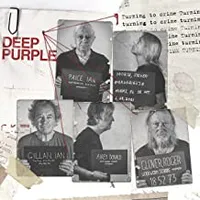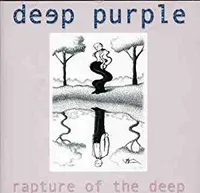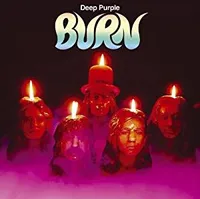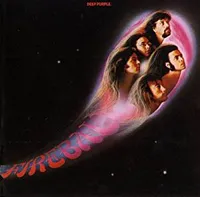Every Deep Purple album ranked, from worst to best
Deep Purple's albums ranked, from patchy Purple to purple patches, from iconic albums to the one Ritchie Blackmore dubbed "cattle grazing" to the one with the new chap

It’s approaching Christmas Day 1971. As a young teenager, this writer is eagerly looking forward to the morning of December 25, when among the presents under the tree will hopefully be a copy of Deep Purple’s latest album, Fireball.
Fast-forward 50 years to the present day. As an increasingly decrepit 60-something-year-old, this writer is perched on a stool in the kitchen on a Sunday morning, raising a toast to Deep Purple’s epic career. (Actually it’s the toaster that’s raising toast; I won’t be quaffing a brandy until noon at the earliest.) And FYI, I still own that original copy of Fireball.
The story of Deep Purple is truly one of rock’s great soap operas. (No wonder they decided to put Fairy Liquid bubbles on the cover of 1973 album Who Do We Think We Are.) The band’s roots can be traced back to 1968 (some say 1967) when Searchers drummer Chris Curtis contacted London businessman Tony Edwards to pitch the idea of creating a British rock supergroup. Curtis had the foresight, but he also had a penchant for LSD and unpredictable behaviour – as evinced by his decision in ’69 to quit the music business and join the Inland Revenue. (Boy, were people’s tax returns fucked up that year.)
Still, Edwards took up the baton. In cahoots with partner John Coletta, and along with a hot young keyboard player called Jon Lord, he began recruiting musicians to realise Curtis’ somewhat frazzled vision. Briefly called Roundabout (a remnant of Curtis’ plan to form a band around a small core of players; they would be joined by a revolving guest-cast who’d jump on and off a musical ‘roundabout’), Purple debuted in 1968 with their Shades Of… album. Fearsome tracks such as Mandrake Root and the cover of Hush promised much, but something was amiss; in truth, they couldn’t decide whether they wanted to be Iron Butterfly or the Moody Blues, plus singer Rod Evans’ style was grounded in the hip-swinging 60s.
The arrival in 1969 of frontman Ian Gillan and bassist Roger Glover (replacing Nick Simper) improved things beyond belief. Thus the band’s classic Mk II line-up was born, the new pair joining Lord, guitarist Ritchie Blackmore and drummer Ian Paice in a match made in heaven… and, later, hell. The Purps have always thrived on musical tension, but internal aggravation would eventually rip them asunder. Blackmore and Lord were at loggerheads initially; then the Man In Black turned his flinty-eyed attention to Gillan. Still, that didn’t prevent Mk II reuniting not once, but twice.
All that festering resentment seems – indeed, is – a long time ago now, with the current DP line-up – Gillan, Glover, Paice, guitarist Simon McBride and keyboard player Don Airey – seemingly enjoying a new lease of life following many years of stability with McBride's predecessor, Steve Morse.
Over time, Purple have survived an ill-fated ‘funky period’ spearheaded by one-time bassist/vocalist Glenn Hughes. They’ve reeled from the deaths of US guitarist Tommy Bolin, who some claim was badly suited (well, he did wear kaftans and geisha boots), and, more recently, Jon Lord. They had another taste of mortality in 2016 when Ian Paice suffered a mini-stroke while on tour in Sweden, missing Purple gigs for the first time since 1968. Also in 2016 the band were inducted into the Rock And Roll Hall Of Fame. Blackmore was a notable absence on the night, David Coverdale branding Ritchie’s no-show “an obscenity”.
Over the years Purple have always resisted the clamouring from a small but vociferous hard-core of fans to get the Man In Black back in the band for one final fandango. (As has Ritchie himself, to be fair.) Ian Gillan has frequently poured cold water on the notion, saying that reuniting with the legendary former guitarist would be “no fun at all” for all concerned.
Purple are patently Gillan’s band these days, no matter how much he might claim democratic immunity. There follows a look back at an often stellar, sometimes stuttering, but always highly intriguing album career.

25) The Battle Rages On (1993)
The Battle… is the last album recorded by the third coming of DP’s classic Mk II line-up, although sadly not much is classic about its contents. The opening title track is admittedly a barnstormer, the band sounding as spiky and furious as a pugnacious porcupine, but from that moment on it’s all downhill.
Eventually Ritchie Blackmore stormed out for good, apparently referring to the record as 'The Cattle Grazes On' – not-so-slyly indicating that Purple were being put out to pasture. In fact, nothing could be further from the truth.
Purple’s first album with Don Airey on keyboards has a terrible title (referencing a bonkers EU ruling that shops should start selling straight bananas). It also received a terrible review in Classic Rock, underneath the headline ‘Fruitless Pursuit’.
Notable moments are few. The ballad Haunted features a string ensemble and additional vocals from Beth Hart; Steve Morse’s Contact Lost, about the Columbia Space Shuttle disaster, may be only 1:27 long here, but it’s spine-chilling when he plays it live.
“Mostly, the band seem content to exist within their limits,” Jon Hotten’s CR review concluded. Which, for Purple, just ain’t good enough.
As 1969 drew to a close, changes were afoot in the Purple ranks. They still hadn’t cracked the UK market; additionally, their US march had stalled. The album cover – featuring a detail from Hieronymous Bosch’s saucy The Garden Of Earthly Delights – upset some US record shops, which refused to display it on their shelves.
With Blackmore and Lord intent on pursuing a heavier direction, this was Rod Evans’ swansong, his vocal style deemed too easy-on-the-ear and rooted in the 60s. Nick Simper would also depart, spelling the end of the Mk I line-up. Unusually for an early DP album, there’s only one cover version – Donovan’s Lalena – and a sense of schizophrenia prevails.
23) Concerto For Group And Orchestra (1970)
With its combo of rock’n’roll and the classics, Concerto… paved the way for similar indulgences by the likes of Kiss and Metallica. Yet it polarised opinion back in 1970, many regarding it as conceit from a remodelled band (Mk II) yet to prove itself. One music paper called it “pseudo classical drivel”.
Gillan went on to sing on the Jesus Christ Superstar album, adding weight to the belief that two worlds were colliding rather than co-existing. Concerto…’s 2012 re-recording – tragically also the year of Jon Lord’s death – improved its profile, yet to some it remains more chalk and cheese than cheese and biscuits.
22) The Book Of Taliesyn (1969)
Like their debut, Purple’s second album contains an oddball mix of covers and originals. Of the covers, Neil Diamond’s Kentucky Woman is more carrot than carat, but the 10-minute River Deep, Mountain High still sounds spectacular (Rod Evans’ P.J. Proby-esque vocals notwithstanding).
Less self-assured than its predecessor, The Book Of Taliesyn suffers from a 60s Beat Boom hangover and forced/faux psychedelia: King Crimson one minute, Jefferson Airplane the next. Still, it’s notable for an early example of Blackmore/Lord guitar/keys muscle-flexing on loose’n’lethal instrumental Wring That Neck.
21) The House Of Blue Light (1987)
With Gillan and Blackmore at each other’s throats once again, tension between the warring duo adversely affected the reconstituted Mk II’s second full-length. The House OIf Blue Light is littered with dreary, workaday tracks such as The Unwritten Law and Call Of The Wild, prompting the Deep Purple frontman to say: “I can’t feel the spirit of this band. I can see or hear five professionals doing their best, but it’s not functioning.”
Still, look on the bright side. Mitzi Dupree is about an “entertainer” Gillan once encountered – a woman who employed her nether regions to fire ping-pong balls with unerring accuracy.
20) Who Do We Think We Are (1973)
An impossible dream: create an album better than, or at least as good as, Machine Head. The band were on a hiding to nothing. Non-stop touring had left them exhausted, and Gillan and Blackmore’s relationship was at breaking point.
The Purps retreated to a villa in Italy to write but only came up with two songs. Forcing themselves off their sun-loungers, they completed sessions in Germany, but by this point were “a fractured band”, by Gillan’s own admission. Wildly inconsistent Who Do We Think We Are may be, but that didn’t stop it gaining a Top 5 placing in the UK. Plus it’s got the tremendous Woman From Tokyo on it.
After a flirtation with Joe Satriani, Purple brought in guitarist Steve Morse – and emerged re-born. As Roger Glover told this writer: “When Steve arrived everyone climbed out of their 10-year depression. Jon and Ian started playing better than ever, and Gillan just went nuts, coming up with loads of ideas. We blossomed.”
Showcasing a more thoughtful and musicianly Purple, and laying the foundations for the band’s direction in the noughties and beyond, Morse’s eclectic influences are all over stuff like Hey Cisco, Rosa’s Cantina and The Aviator. Standout track Sometimes I Feel Like Screaming covers multiple bases (elegiac, aggressive, emotional… you name it).
Purple’s second album with Steve Morse is uncompromising and remarkably close to the no-holds-barred spirit of Mk II. It begins with the tough-talking Any Fule Kno That and climaxes with Bludsucker, a sly reworking of Bloodsucker from In Rock.
In-between, Gillan channels his rock’n’rollin’ Garth Rockett persona on Almost Human; the slow blues of Don’t Make Me Happy is somewhat reminiscent of (whisper it) Ritchie Blackmore’s Rainbow; and Seventh Heaven features some of Morse’s most volatile guitaring to date. On our favourite track, ’69, Gillan recalls the joys of being on the road in his formative years. An underrated album.
The Purps become perps on this album of cover versions – and it’s an absolute blast. Its mid-table position is perhaps a trifle unfair but it’s difficult to justify placing a record of non-originals higher. For the first time the band collaborated remotely, their hi-tech antics born out of necessity due to the Covid outbreak. (From Whoosh! to Zoom, you could say.)
Turning To Crime reflects the band’s – and specifically Ian Gillan’s – love of the early days of rock’n’roll. But the real fun is to be had in spotting the Easter eggs. Don Airey sneaks in a snippet of Smoke On The Water during Rockin’ Pneumonia And The Boogie Woogie Flu, and if that cheeky keyboard passage at 2:32 into Let The Good Times Roll has you scratching your head as to its origin, we can reveal it’s lifted from Big Dee Irwin/Little Eva’s Swingin' On a Star. All this, and a blast of Led Zeppelin’s Dazed And Confused as well. No Uriah Heep though.
16) Rapture Of The Deep (2005)
After the disappointment of Bananas, Rapture Of The Deep marked something of a return to form. Recorded in a quickfire five weeks, the band sound simultaneously laid-back and assertive, with a selection of songs that may not be classics of the Purps’ pantheon but are damn intriguing all the same.
There’s a wide variety of moods: Kiss Tomorrow Goodbye has an angry political message; the title track’s exotic vibe is rooted in its original title, Turkish Delight; Clearly Quite Absurd is an extremely English-sounding ballad, its affecting lyrics reminiscent of a romantic Wordsworth poem. It’s worth tracking down bonus track MTV, where Ian Gillan takes a serious dig at air-headed media types.
First things first: the album cover is dreadful, like something you’d see painted hastily on the side of Mystic Lil’s tarot emporium on Brighton pier. The sole Purple album with vocalist Joe Lynn Turner, many reckon S&M (see what they did there?) to be the nadir of the band’s career. Wrong!
Turner puts in a sterling performance, Ritchie is revitalised and Glover’s production is excellent. King Of Dreams is full of cool menace; the classically inclined Love Conquers All pushes all the right power-ballad buttons; Breakfast In Bed is fine if you like your morning OJ laced with vodka. This might sound like Bad Company playing Survivor’s back catalogue, but so what?
Working with producer Bob Ezrin refocused Purple, giving their songs a much-needed extra dimension and the band themselves more urgency than they’d had in a very long time. The result was Now What?!, arguably the best album since 1984’s Perfect Strangers – and one that stands as a fitting tribute to the late, lamented Jon Lord, who died the previous year.
Case in point: the doomy, ominous and heavy Vincent Prince, showing that Purple could still sound like a contemporary combo without losing any of their original edge.
Infinite definitely won’t disappoint fans of classic Purple. It’s a feast of wanton organ and quasi-classical keyboard curlicues, bolstering bass from Glover and percussive surges courtesy of Paice. Gillan, meanwhile, is in grand over-the-top form, trying a little too hard, perhaps, to keep up with the heavy metal kids, effing and blinding throughout. Elsewhere, he’s ‘three sheets to the wind’ in One Night In Vegas, while On Top Of The World finds him variously lying ‘beside the most beautiful girl in the universe’ and ‘collapsed between the eyes of Morpheus’.
It’s colourful and inadvertently comical stuff, but there’s no denying that the music is worth taking seriously, from the rampaging opener Time For Bedlam and exotically textured The Surprising to the Zep-ish Hip Boots and Birds Of Prey. The album closes with a perfunctory cover of Roadhouse Blues, but Infinite works best when Purple do what they do best: extrapolate and alchemise the blues, and take it to new progressive heights.
If you thought Purple couldn’t come up with a more bananas title for an album than, er, Bananas, ladies and gentlemen, let us present: Whoosh! When quizzed about said moniker, Ian Gillan muttered something about it being an onomatopoeic representation of the transcience of mankind. (To us, it’s just the sound our computer makes when it sends an email.)
Regardless, this is another very fine offering from the modern-day Purple; why, even the NME called it “ludicrously flamboyant… an album that can and should be enjoyed without over-thinking”. Another review described Whoosh! as “undeniably a Deep Purple record” – which, when you think about it, is just about the biggest compliment out there.
The third successive Deep Purple offering made with Bob Ezrin at the production helm, highlights include the enigmatic The Power Of The Moon; Drop The Weapon, a chilling condemnation of modern-day street violence; the slow-burning rocker Man Alive (thematically linked to the album title); and a fresh version of And The Address, the instrumental opening of 1968’s Shades Of Deep Purple.
In 2022, long-term guitarist Steve Morse departed to care for his ill wife. With Ian Gillan, Roger Glover, Ian Paice and Don Airey in their 70s, nobody could have forgiven them catching up on a few Midsomer Murders afternoon repeats. Instead, they doubled down and knuckled down. Morse was replaced by a relatively young pup: 45-year-old Ulsterman Simon McBride, once of Sweet Savage (who also once included Def Leppard’s Vivian Campbell).
The Purple of =1 harks back to both Purple's early-70s pomp and the early-80s MKII rebirth, with McBride bringing a youthful energy, and when he lets loose on I’ll Catch You and sizzles his way through A Bit On The Side it’s clear he’s both his own man and the right man. Even better, the other band members – notably Gillan and Airey – sound reinvigorated too.
After DP Mk III’s triumphant debut on Burn, you could say Stormbringer typifies the ‘difficult second album’ syndrome (even though it’s actually Purple’s ninth). Ritchie Blackmore was in an even darker mood than usual during sessions in Munich, having to simultaneously deal with an ugly divorce.
The soon-to-depart guitarist was also perturbed by the introduction of Glenn Hughes-fuelled funky elements. Even so, there are some glorious moments, including the thunder-seekin’ title track and the slow-burning Soldier Of Fortune. But Glenneth-dominated compositions such as You Can’t Do It Right (With The One You Love) and Love Don’t Mean A Thing are emphatically not Purple.
Purple’s first studio album in nine years, and the first with the Mk II line-up for 11 years. Was it worth the wait? Yes and no. Casting one’s mind back to 1984, Deep Purple’s comeback didn’t cause quite the kerfuffle you might’ve expected. With the New Wave Of British Heavy Metal still fresh in everyone’s minds, and with the thrash metal movement building in intensity (Metallica’s Ride The Lightning had recently been released), Perfect Strangers was received warmly, but not rapturously.
It’s a solid, consistent album but lacking a spark of genius. Purple were still a peerless live band, however, as they proved with a memorable (if terminally rain-soaked) performance at Knebworth the following year.
It seemed as though Purple were consigned to the history books by the time this live album emerged in October 1976. The Mk IV band, with Tommy Bolin on guitar, had imploded earlier in the year, and with Blackmore’s Rainbow in the ascendancy, Deep Purple’s future looked non-existent.
This features the Mk III version (Coverdale, Hughes et al) and, despite being recorded toward the end of that line-up’s lifespan, it’s an absolute diamond. Featuring a handful of the band’s very best songs from Burn and Stormbringer, Cov puts in an endearingly over-enthusiastic performance, bellowing like a pregnant hippo on Mistreated and Lady Double Dealer.
7) Shades Of Deep Purple (1968)
Deep Purple’s debut caused barely a ripple when it was released in the UK in September ’68. By contrast, America immediately took the band to its heart, their blistering rendition of Joe South’s Hush becoming a Top 5 US hit. Other cover versions include Prelude: Happiness/I’m So Glad, a bizarre amalgam of Rimsky-Korsakov and Skip James.
The key to future greatness lies in the pulsating malevolence of Mandrake Root, a track every bit as good as anything on Machine Head. DP Mk I, with vocalist Rod Evans and bassist Nick Simper, is often unfairly overshadowed by Mk II – a fact that’s definitely in evidence here.
Deep Purple were on a hiding to nothing with Come Taste The Band. Replacing Ritchie Blackmore with flashy American upstart Tommy Bolin – billed as “the best new guitar player in the world” but harbouring a deadly heroin addiction – caused outrage among UK fans. In later years Jon Lord reflected: “I don’t think it’s a Purple record at all.” While Glenn Hughes described it as “kind of like Bad Company through a funny mirror”.
Despite those comments, we reckon Come Taste The Band is a brilliant record. Super-slick, hyper-glossy and imbued with a soaraway 70s vibe, it makes one crave for the follow-up that never was. Deep Purple’s darkest hour? Don’t believe it.
If Fireball is Ian Gillan’s favourite Mk II album, then Made In Japan is Ian Paice’s. “It’s probably the best live rock’n’roll record ever made,” he once told this writer proudly. “As a tour de force of innovation and living on the edge, together with great playing and a fantastic sound, nothing comes close.” Jon Lord concurred: “It’s the epitome of what we stood for in those days.”
Purple are at the height of their powers, straddling an indelicate line between intense and indulgent, monstrous-sounding and meandering. It helped that the concept of a rock band playing gigs in the far-flung Far East was impossibly exotic in the early 70s, giving the album a real cachet.
To many people, only 24-carat Purple will do. As the late Jon Lord told this writer: “When Mk II split, Purple stopped. I know we carried on with David [Coverdale] and Glenn [Hughes] and then Tommy [Bolin], but it was never quite the same.”
Nevertheless, Mk III – with Cov and Glenneth in place of Gillan and Glover – has stacks to recommend it (and we ain’t just talking about DC’s platform footwear). The inspirational arrival of the singing salesman from Redcar and the Cannock funkster gave Purple a new sense of purpose, however briefly. The title track, Might Just Take Your Life and the sprawling Mistreated are instant classics, for starters.
Fireball is Ian Gillan’s No.1 album from Purple’s Mk II period: “We brought in the funk, the blues, the soul, the jazz and some of the psychedelic hangovers from our early days… Without it we would never have been able to make Machine Head.”
Numerous high points include the raging title track; the luscious groove of No No No; Demon’s Eye’s Son Of My Father-style beginning; and the deeply proggy The Mule. That’s not to mention Gillan’s unhinged performance on Fools, or the off-the-cuff No One Came where he raps rather than sings. If Machine Head has become over-familiar, then Fireball is ripe for rediscovery.
This album was a turning point. Suddenly, belatedly, people began to realise that Messrs Gillan, Blackmore, Lord, Glover and Paice weren’t a Led Zeppelin or a Black Sabbath; neither were they the “pop” Purple of the late 60s.
The band had hit on a unique, loose-limbed formula and were determinedly carving their own niche. Machine Head is a pivotal album because it set the template for Purple’s entire future direction. And, of course, it’s packed with timeless gems such as Smoke On The Water, Lazy, Highway Star and Space Truckin’. Purple’s stratospheric rise was also boosted by an edit of Smoke… that gave them a hit in America.
Galvanised by, and also resentful of, the popular perception of Jon Lord as Purple’s leader, Ritchie Blackmore comes alive here. No one was playing guitar with such speed and dexterity as the 60s switched into the 70s.
Beginning with Speed King and Bloodsucker, the unwitting listener was left bruised and battered by the Purps’ new attack-minded approach. True, Child In Time has dated badly, despite Gillan’s unfeasible vocal performance. But Side Two (as was), with the killer quartet of Flight Of The Rat, Into The Fire, Living Wreck and Hard Lovin’ Man, is non-stop mayhem.
Forget the NWOBHM, this is where Metallica got their chops.
Sign up below to get the latest from Classic Rock, plus exclusive special offers, direct to your inbox!
Geoff Barton is a British journalist who founded the heavy metal magazine Kerrang! and was an editor of Sounds music magazine. He specialised in covering rock music and helped popularise the new wave of British heavy metal (NWOBHM) after using the term for the first time (after editor Alan Lewis coined it) in the May 1979 issue of Sounds.



























